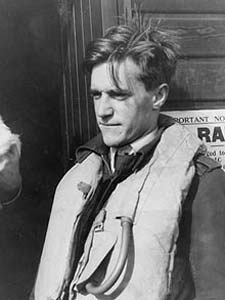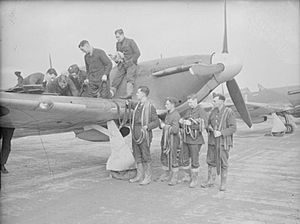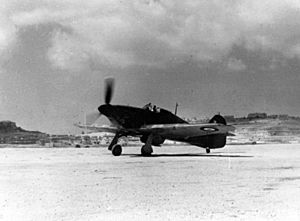Robert Barton (RAF officer) facts for kids
Quick facts for kids
Robert Barton
|
|
|---|---|

Barton, 1941–42
|
|
| Nickname(s) | Butch |
| Born | 7 June 1916 Kamloops, British Columbia, Canada |
| Died | 2 September 2010 (aged 94) Kamloops, British Columbia, Canada |
| Allegiance | Canada |
| Service/ |
Royal Air Force |
| Years of service | 1936–1959 |
| Rank | Wing Commander |
| Commands held | No. 249 Squadron RAF Skeabrae RAF North Weald RAF Acklington |
| Battles/wars | Second World War |
| Awards | Officer of the Order of the British Empire Distinguished Flying Cross and Bar Mention in despatches |
Robert Alexander Barton (June 7, 1916 – September 2, 2010) was a brave pilot from Canada. He joined the Royal Air Force (RAF) and became a hero during the Second World War. He was known for shooting down at least 12 enemy planes!
Born in Kamloops, British Columbia, Robert Barton joined the RAF in 1936. He flew Hawker Hurricane fighter planes. He fought in the famous Battle of Britain and later helped defend Malta. For his courage, he received the Distinguished Flying Cross. After the war, he stayed in the RAF and even helped start the Pakistani Air Force. He passed away in 2010 when he was 94 years old.
Contents
Becoming a Pilot
Robert Alexander Barton was born in Kamloops, Canada, on June 7, 1916. His dad was Canadian, and his mom was Scottish. He grew up in Penticton and went to school in Vernon. In 1935, he decided he wanted to fly! He applied to join the Royal Air Force (RAF) in England.
Robert, who was nicknamed 'Butch', started his flight training in January 1936. He learned to fly amazing planes. By early 1937, he was a pilot officer. He joined No. 41 Squadron, which flew Hawker Fury biplanes. Later, in 1939, his squadron started flying the faster Supermarine Spitfire fighters.
World War II Heroics
When the Second World War began, Robert Barton was a flying officer. In May 1940, he joined a new group called No. 249 Squadron. This squadron flew Hawker Hurricane fighter planes. They became ready for battle in July and soon joined the intense air fights over England.
Battle of Britain Flights
On August 15, Robert Barton got his first victory! He shot down a Messerschmitt Bf 110 heavy fighter. He also damaged another one that day. On August 24, he destroyed two Messerschmitt Bf 109 fighters near the Isle of Wight. He even shared in shooting down a Dornier Do 17 bomber on September 2.
The very next day, Robert's plane was hit during a fight over the Thames Estuary. He had to parachute out, but he landed safely! He was promoted to flight lieutenant in September. On September 11, he helped damage four Heinkel He 111 bombers. On September 15, known as Battle of Britain Day, he shot down one Do 17 and damaged another. He shot down another Bf 110 on September 27.
The fighting was very tough, but the German air force (Luftwaffe) started to slow down in October. On October 22, Robert Barton was awarded the Distinguished Flying Cross for his bravery. This award recognized his "outstanding leadership" and how he helped his squadron succeed. He had personally destroyed four enemy aircraft and helped destroy others.
A week after getting his award, Robert destroyed a Bf 109 and damaged two more. He also probably destroyed another Bf 109 on November 7. Four days later, he shot down a Junkers Ju 86 bomber. By early 1941, Robert was leading his squadron as an acting squadron leader. On February 4, he shot down a Bf 110 and damaged another. These were his last victories while flying from England.
Defending Malta
In May, Robert's squadron was sent to the Middle East. They flew their Hurricanes from the aircraft carrier HMS Ark Royal to the island of Malta. They were supposed to refuel and fly to Egypt, but instead, they were told to stay and help defend Malta! They even had to swap their new Hurricanes for older, worn-out ones from another squadron.
No. 249 Squadron started flying missions from Malta on May 25. The German air force had moved to fight in Russia, so the Italian air force was attacking Malta. On June 3, Robert shot down an Italian Savoia-Marchetti SM.79 bomber over Gozo, near Malta. Four days later, flying at night, he destroyed a Fiat BR.20 bomber. He also shot down two Macchi C.200 fighters in July.
The old planes caused problems. On August 1, Robert's engine failed during takeoff, and he had to crash-land. His plane caught fire, and he got second-degree burns. After recovering in the hospital, he returned to flying. On September 4, he probably destroyed a Macchi C.200. On October 19, he and another pilot shot down a Savoia-Marchetti SM.81 bomber. His last victory was on November 22, when he destroyed a Macchi C.202 Folgore.
In December, Robert returned to England for a rest. His amazing work in Malta earned him another award: a Bar to his Distinguished Flying Cross! This meant he had received the DFC twice.
Later War Service
For the rest of the war, Robert Barton mostly worked as an instructor and in leadership roles. He commanded RAF stations at Skeabrae in Scotland and at North Weald in England. In 1945, he was mentioned in official reports for his good work.
By the end of the war in Europe, Robert Barton was a wing commander. He was also given another honor, becoming an Officer of the Order of the British Empire. By the end of the war, he was officially credited with destroying twelve enemy aircraft by himself and helping to destroy five others. He also probably destroyed two planes and damaged nine.
Life After the War
In August 1945, Robert Barton went to British India. He helped create the Pakistani Air Force after India became independent in 1947. Later, he returned to the United Kingdom and held various command and staff jobs, including leading the RAF station at Acklington.
Robert retired from the RAF in February 1959. He and his wife, Gwen, moved back to British Columbia, Canada, in 1965. Robert Barton passed away in Kamloops on September 2, 2010, at the age of 94. His ashes were scattered in a lake on September 15, the anniversary of Battle of Britain Day.



